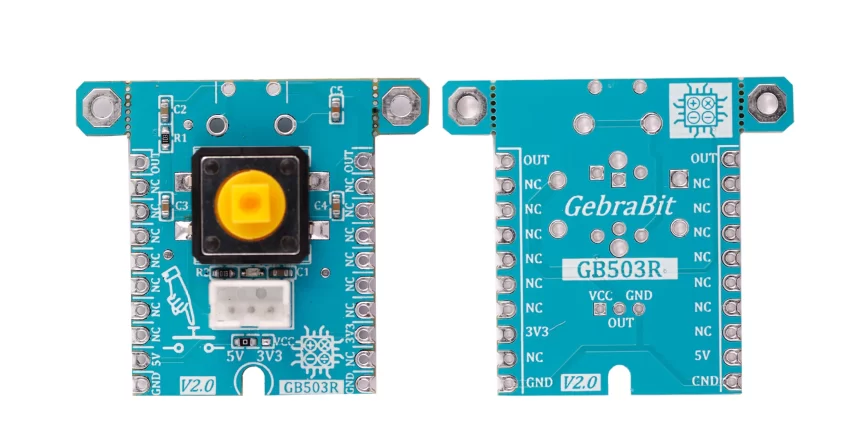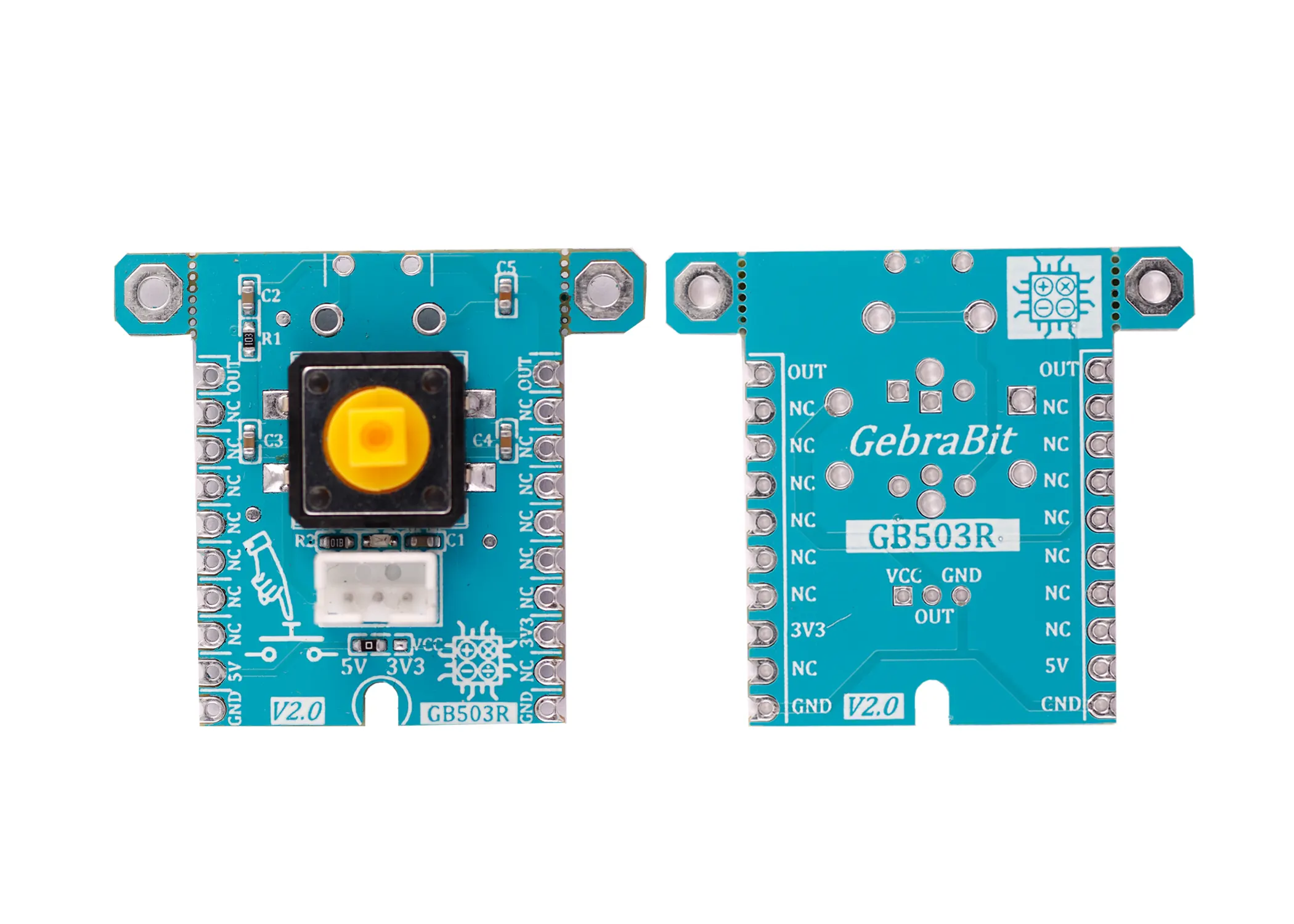A push button switch is a mechanical device used to control an electrical circuit in which the operator manually presses a button to actuate an internal switching mechanism. They come in a variety of shapes, sizes, and configurations, depending on the design requirements.
They can be employed to break (off) or initiate (on) a circuit. Alternatively, they can provide an input for the user interface of a piece of equipment or start/stop a particular function.

GebraBit Push Button module

GebraBit PUSH BUTTON module features various pushbutton footprints such as DIP, SMD, and right-angle ones and can operate with “3V3” or “5V” supply Voltages by considered “VCC SEL” jumper selector.
By pressing the pushbutton, the “OUT” pin is set to LOW and the LED turns on.
For easy accessibility, GebraBit PUSH BUTTON gives access to the “OUT“, “VCC“, and “GND” pins by a 3-pin PH connector to extend them on other board easily.

To start this module, just put the GebraBit PUSH BUTTON module in the BreadBoard, then by applying a proper voltage and pressing the push button you can get the “LOW” output through “OUT” pin . Due to the compatibility of the GebraBit LED pins with the GebraBus standard,we recommend using GebraBit microcontroller development modules for testing and commissioning.
Module Specification
Module Application
- Module Supply Voltage : 3.3 V or 5.0 V
Module Logic Voltage : 3.3 V or 5.0 V
Module Current Consumption : 10 mA to 30 mA (Typ. 20 mA)
Output Type : Digital-Logic
- Robotic
Module Key Features
- Features various pushbutton footprints
- User-selectable module power supply voltage between 3V3 and 5V
- Pushbutton status LED
- Data Pin access with PH connector
- On Board, ON/OFF LED indicator
- Pin Compatible with GEBRABUS
- It can be used as a daughter board of GebraBit MCU Modules
- Featuring Castellated pad (Assembled as SMD Part)
- Separatable screw parts to reduce the size of the board
- Package : GebraBit small (36.29mm x 32.72mm)
Introduction of module sections

Push Button
Push button switch is placed in the central part of the module.

signal ports
For easy accessibility, GebraBit Push Button gives access to the “OUT“, “VCC“, and “GND” pins by a 3-pin PH connector to extend them on other board.
users can access to these pins by connecting a proper female PH connector to this connector.
In this module, as shown in the below pic, the connector pins correspond to the “GND”, “OUT” and “VCC” pins of the module, from left to right.

VCC SEL jumper
According to the state of 0R resistance of this jumper, the module main supply voltage is selected between “5V” and “3V3”.

Push Button LED
By pressing the pushbutton, the Push button LED turns on.

GebraBit Push Button Module pins

Supply pins
- 3V3 and 5V: These pins can provide the main power supply of the module according to the state of the “VCC SEL” Selector Jumper.
- GND: This is the ground pin of the module.

OUT pins
OUT: This pin is the output pin of the module, which is designed on both the left and right sides. this pin sets to HIGH (1) mode by default and by pressing the push button, it sets to LOW (0) mode.

Connect to the processor

connect to GebraBit ATMEGA32A and STM32F303
To Set-up the GebraBit Push Button with the GebraBit ATMEGA32A or GebraBit STM32F303 you can simply place the GebraBit Push Button module as pin to pin on the GebraBit ATMEGA32A or GebraBit STM32F303 module and start the module by applying the proper voltage.
Here for better understanding the separate connection of the modules is shown.

You can set-up the GebraBit Push Button to the GebraBit STM32F303 module in the same way.
Note: If you are using GebraBit microcontroller modules, note that the “VCC SEL” jumper of GebraBit Push Button module is set to “3V3” so that you can easily get “3V3” voltage from the microcontroller module.
connect to ARDUINO UNO
follow the below steps to connect the GebraBit Push Button module to the ARDUINO UNO:
- Since the “VCC SEL” jumper is set on “5V”, Connect the “5V” pin of GebraBit Push Button module to the “5V” output pin of the ARDUINO UNO board. (red wire)
- Connect the “GND” pin of the GebraBit Push Button module to the “GND” pin of the ARDUINO UNO board (black wire).
- Connect the “OUT” pin of the Push Button module to one of the ARDUINO UNO “PWM” pins (e.g. D9). (yellow wire)
You can see how to connect the above mentioned steps, in the below picture:



